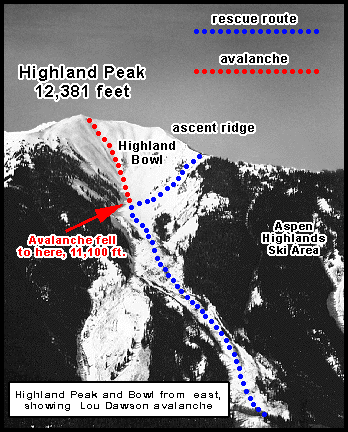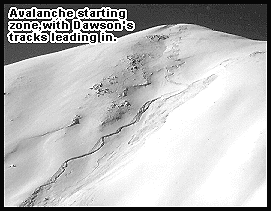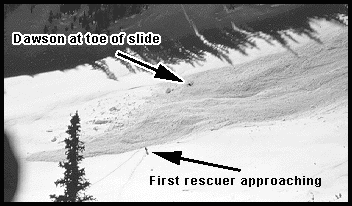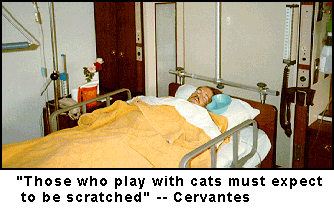By Lou Dawson (with help from Ted Kerasote)
(2022: Look for a fleshed out version of this story in Lou Dawson’s forthcoming book. More on that as his project progresses.)
Aspen, Colorado. For myself and John “Izzo” Isaacs, the morning of February 19, 1982 dawned clear, calm and filled with excitement. At 3:30 AM we strapped climbing skins to our skis, and began the long climb via the Highlands Ski Area to the summit of Highlands Peak. We intended to ski Highland Bowl, the stupendous amphitheater formed by the north and south ridges of the peak. Hundreds of avalanches fall here each winter. Most of these grind to a halt on the low angled “flats” midway between the summit and valley. But during heavy winters, monster slides roar almost a vertical mile to the valley floor.
In 1982 Highlands Bowl was closed by law to most skiers (it is now part of the ski area’s “hike to” terrain).
The Bowl dominates the view from Aspen Mountain, Aspen’s ski area. For years, backcountry skiers have proudly scribed their bowl tracks for all on Aspen Mountain to see. Moreover, the Highland Bowl is federal public land. It had been part of the Aspen Highlands ski permit for years, but was rarely used by the ski area, and was always “closed.” Such closure gnawed at many a skier’s sense of personal freedom. Thus, aside from artistic statements or braggadocio, locals cut tracks in the bowl to assert their property rights.
I was no stranger to this arena, having played the powder games many times, and for many reasons. But I’d never skied the Bowl’s most radical line: “B-1” (now known as Be One on the Highlands trail map, and in reality an avalanche controlled bump run far removed from its natural state), a steep gully dropping 1,300 vertical feet down the east face of Highland Peak. As local wags said, you were not a member of the “Highlands Bowling League” until you ran B-1.
Izzo and I were at the top of our sport. Since early fall we’d skied big bowls and steep avalanche chutes. We had recently completed a traverse of the Elk Mountains that included more than a week of extreme descents. During the previous winter, Izzo had completed an awesome three month ski traverse of the California Sierra. Our knowledge of slide danger was tuned to a fine pitch. Yet success would be my fall. I had lost my fear and replaced it with stupidity. A mountaineer with no fear has no judgment — and stupid reigns supreme.
Alpenglow gleamed off the high peaks as we climbed past the last chairlifts of the ski area and turned towards the ridgetop. To our left was Castle Creek and Aspen Mountain, to our right the 14,000 foot Maroon Bells loomed, Aspen’s most famous mountains. The rising sun was warm. I felt happy, strong — and anxious. Izo and I knew that the ski-patrol would be leading a guided tour of steep-and-deep skiers into the Bowl early that morning. Hence our early start. If caught we would be arrested and fined.
Pushed by our egos as well as a thief’s concern for not being found, we hurried. We made mistakes. Though we did take basic precautions. We carried the standard avalanche beacons, shovels and probe poles. We were warmly dressed in the latest outdoor clothing. We also skied one at a time — a crucial factor in avalanche safety.

View of Highland Bowl from east, now a well known part of Highlands resort.
After a few turns, I felt a marked change under my skis. My ski tails sank deep into a layer of depth hoar (ubiquitous “sugar snow” that causes most Colorado killer avalanches). My optimism vanished like snow on a wind scoured ridge.
Safety was a few feet away, where Izzo stood at the edge of the gully. I turned that direction intending to take a decision break on safe ground. It was too late. I’d only moved a few feet when a vertical fracture opened between me and my only hope for safety. A split second later, the snow I was on began to slide.
I was soon caught in a comber of snow — a power of nature, like the break of a tsunami. Spun and flipped over, I felt my arms and legs thrown like a rag doll’s. All was darkness and violence as I tumbled faster and faster, losing all control. With a bone jarring explosion my left femur broke as it surrendered to impossible force. I hadn’t hit anything — bone had sheared in cross currents of snow. Then I slammed into a hard surface which, reconstructing the accident after, I realized was the lip of a headwall near the bottom of the Bowl.

Tom Hicks photo of Dawson track leading into avalanche starting zone.
The lip launched me into space. As I flew through the air, still engulfed in the powder cloud, I had a brief respite of unearthly quiet. A flash of light, then the avalanche hit the flats and skimmed with spine bending force over blocks of snow from past slides. The snow slowed down quickly, I felt G-force like a car screeching to a panic stop. Fear. I was to be entombed. A panting breath, then all was still. I passed out.
I flailed my arms toward a glow of light. Then — a miracle: After the maelstrom only a few inches of snow covered my head. I freed my arms. I was lying on my side, head downhill, packed tightly in the slide. Both my legs were broken. I struggled wildly but pain forced me to lie still. I looked up the slide path and saw Izo on foot, still near the top of the Bowl. He moved closer, stopping to search piles of snow with his beacon (avalanche beacons have a short range). He couldn’t see me in shadow far below. I didn’t shout — I didn’t have it in me. Later we figured I’d dropped from near the top of Highland Peak to the flats in at most seventeen seconds — at speeds around 80 mph.
Izo reached me and dug me out. A speedy rescue was now our priority. I was in danger of shock, hypothermia, and internal bleeding from my broken femur. Indeed, in medical triage a femur break is considered a life threatening injury: 50% of broken femur victims die.
After he fixed my clothing and arranged me on a bed of snow, Izzo climbed back to the rim of the Bowl, then to the ski area. To his surprise, the ski-patrol was on its way. Unknown to us an Aspen man, Bob Limacher, had been watching Highlands Bowl from his house, through a telescope. He saw saw the entire event and immediately notified the authorities.
Keep in mind that a cell phone system did not exist in 1982. In those days, even a place as close to civilization as Highlands Bowl was as good as being in remote wilderness unless you had some sort of two-way radio linking into law enforcement dispatch, which we did not have.

We feel so powerful when things go right, but we are so small when they do not.
Thanks to Bob, Izzo, and the ski-patrol, at 11:00 A.M. I was in Aspen Valley Hospital. My rescue took two hours, including a harrowing toboggan ride in a cloud of pain — until I passed out. Any longer in the Bowl and I would have died on the flats after surviving the slide. Bob Limacher saved my life, as did Izzo and the rescue.

In the hospital, time for reflection after nearly dying.
Looking back, that fine morning climbing the peak, the first turns in B-1, and my whirling ride seem to have passed in a few seconds. My months of recovery gave plenty of time to ponder this closest call and my life.
Certainly, in one sense I was stupid. You could say that since this was a closed area, we could have obeyed the rules and been safe. But to us, staying out of the “closed” area simply meant we’d pick from thousands of “open” bowls with similar pleasures — and dangers. Indeed, my slide down Highland Bowl was not a chance happening, nor the result of simple stupidity. The sequence of events took shape long before I awoke that morning. In one sense, the events of February 19 took shape long before my birth — they were decided in the development of a sport that, out of a timeless human need, has determined that risk taking is worthwhile.
If you choose this sort of sport, as I have, you stay alive by using elaborate safety systems. In my case, I had these perfected. But human beings being what we are — proud, competitive, impatient — we sooner or later make a mistake.
On top of that, risk sports give you feelings of invincibility. You come back alive, and you know hubris. These feelings are imaginary — they have nothing to do with the reality of snow moving at 100 mph. Edward Whymper confronted this more than 100 years ago during his first ascent of the Matterhorn. “A momentary negligence may destroy the happiness of a lifetime,” he wrote after four of his companions fell to their death on that famous climb.
Now I know about negligence, mistakes, and hubris. I’m super careful about what routes I ski for winter powder, and I’m picky about which days I go out. Yet I still go. The mountains are still my home. It was those few minutes after the slide stopped and before I got my arms and head out of the snow. Something happened to me then — a private moment. Since then, I try to play by the mountain’s rules instead of mine. I’ll do my best.
Epilogue
The first known avalanche death in Highland Bowl occurred in the late 1950’s when a hunter was swept away. On March 31, 1984, Chris Kessler, Craig Soddy and Tom Snyder were doing avalanche control work in Highland Bowl. The three ski-patrollers set off explosive charges near the top of the Bowl. Their bombs yielded no sign of danger. With tragic false confidence, the trio skied closer to the middle of the Bowl — into the midst of a vast avalanche path. They threw more bombs. The second explosion triggered a slide below the men. Then before the three could escape, a gigantic avalanche fell from above them. All the men died. Tom Snyder had been with the team that rescued me. A tragic irony.
Beginning in 1999, Highland Ski Area began opening portions of Highland Bowl to skiing. By 2001 they were opening terrain all the way to, and including, B-1, which they now call Be One on the trail map.
Backcountry skiers still scratch their defiant graffiti on B-1, usually in early season before the ski area opens and it becomes an avalanche controlled ski run. And many skiers access similar terrain beyond Highland Peak. In spring, after the snow compacts and the ski area is closed, many people ski Highland Bowl in backcountry conditions.
Since the ski-patrol tragedy no one has been caught in a major slide in the bowl, though a tragic avalanche accident in backcountry (not ski area) terrain off the ridge beyond the bowl claimed the lives of John Roberts and Michael Hanrahan in March of 2000, and other deadly backcountry slides have occurred since then.
Letter to Crested Butte Chronicle newspaper 3/28/1982
re Highland BowlDear Sir,
It was with extreme interest that I read the articles in your March issues concerning the Highlands Bowl in Aspen. While patrol leader at the Aspen Highlands in the late 1960s I was, if not the first person to ever ski this bowl, certainly the first person to ever lead a group of skiers down it. I remember vividly making linked turns until I could catch onto the first available tree — I was too scared to stop until I had something to hang on to.I was also the first one to lead tours down the Maroon Bowl, which is the vast, wide-open bowl below the narrow Highland Bowl, or B-1 as they call it now. (Editor’s note: Macintyre is probably speaking of what is now called Maroon Bowl, which is on the opposite side of the peak from Highland Bowl, and drops into Maroon Creek instead of Castle Creek). I also remember one trip with a bunch of Texans when my daughter, Fran Adams, helped me get them all safely out.
The late great avalanche authority Monte Atwater once came to the Highlands to help me out with my avalanche problems. His advise: “Throw out 1,000 rounds and pray.” When I told him I didn’t get a thousand rounds a year to play with, he just said, “Then you’d better be a good prayer.”
All this takes me back to the good old days when I was young and foolish. Thanks for the memories.
Sincerely yours,
John L. Macintyre
Father of Fran and Barbie
Driggs, ID

